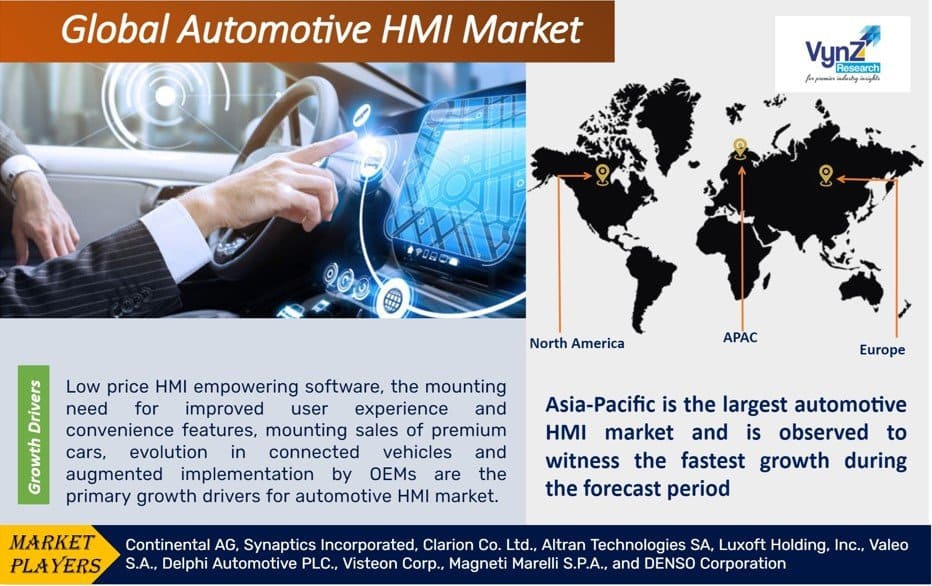| Status : Upcoming | Report Code : VRAT4010 | Industry : Automotive & Transportation | Available Format :

|

Global Automotive HMI Market – Analysis and Forecast (2025-2030)
Industry Insights by Technology Type (Visual Interface, Acoustic Interface, and Others), by Product (Voice Control Systems, Steering Mounted Controls, Central Displays, Rear Seat Entertainment Displays, Head-Up Displays, Instrument Clusters, and Multifunction Switches), Access Type (Standard HMI System, and Multimodal HMI System), and by End Market (Economic Passenger Cars, Luxury Passenger Cars, and Mid-Price Passenger Cars)
Industry Overview
Automotive human machine interface (HMI) is used to manage infotainment features. These systems are effectual in cautioning the drivers about forthcoming difficulties on the road or inside the vehicle. The global automotive HMI market is growing at a significant rate, due to the increasing need for improved user experience and convenience features and beginning of concept cars and electric vehicles in the automotive industry. Different products including voice control systems, central displays (HUD), and head-up displays among others contributed to the automotive HMI market size. The market has witnessed high demand for HUD due to augmented prominence on decreasing driver distraction, it is provided in mid-priced vehicles.

Market Segmentation
Insight by Technology Type
On the basis of technology type, the automotive HMI market is subdivided into the visual interface, acoustic interface and others. Of all the technology types, the visual interface segment accounted the largest share and is expected to grow at the fastest rate in the market, due to inventions in consumer electronic systems, consumer preferences, augmented need for convenient features and incorporation of key interfaces in display systems.
Insight by Product
On the basis of product, the automotive HMI market is subdivided into voice control systems, steering mounted controls, central displays, rear seat entertainment (RSE) displays, head-up displays (HUD), instrument clusters and multifunction switches. Of all the products, the head-up displays (HUD) is estimated to grow at the fastest rate in the market due to augmented prominence on decreasing driver distraction, it is provided in mid-priced vehicles and mounting acceptance of premium cars. In addition, the central displays segment accounted for the largest share of the market.
Insight by Access Type
On the basis of access type, the market is subdivided into standard HMI system and multimodal HMI system. Among the all-access type, multimodal HMI system is expected to grow at fastest rate in the automotive HMI market due to the improvement of security and comfort characteristics of vehicles, the mounting need for premium and comfort characteristics in passenger cars and increasing need for connected vehicles. In addition, a standard HMI system accounted for the largest share of the market.
Insight by End Market
On the basis of end market, the market is subdivided into economic passenger cars, luxury passenger cars, and mid-price passenger cars. Among the all end-use type, the mid-price passenger cars accounted the largest share in the automotive HMI market due to improving user experience within the vehicle such as touch-based infotainment units, Rear Seat Entertainment (RSE) displays and haptic controls, and decreasing driver distraction.
Automotive HMI Market Report Coverage
|
Report Metric |
Details |
|
Historical Period |
2018–2023 |
|
Base Year Considered |
2024 |
|
Forecast Period |
By 2030 |
|
Market Size in 2023 |
$X.XX Billion |
|
Revenue Forecast in 2030 |
$XX.XX Billion |
|
Growth Rate |
CAGR XX.XX% |
|
Segments Covered in the Report |
By Technology Type, By Product, By Access Type, and By End Market |
|
Report Scope |
Market Trends, Drivers, and Restraints; Revenue Estimation and Forecast; Segmentation Analysis; Impact of COVID-19; Companies’ Strategic Developments; Market Share Analysis of Key Players; Company Profiling |
|
Regions Covered in the Report |
North America, Europe, Asia-Pacific, Middle East, and Rest of the World |
Industry Dynamics
Growth Drivers
Low price HMI empowering software, the mounting need for improved user experience and convenience features, mounting sales of premium cars, evolution in connected vehicles and augmented implementation by OEMs are the primary growth drivers for automotive HMI market.
The beginning of concept cars and electric vehicles in the automotive industry, incorporation of multiple technologies, progression in mobility services, technological advancement and upsurge in need for autonomous vehicles are also facilitating the growth for the automotive HMI market.
Challenges
The high price of advance HMI systems, cybersecurity risk, and high power utilization are the major challenges for the growth of automotive HMI market. In addition, extended production cycle of the automotive vehicle, interruption of driver and luxurious interior at the lesser price are also hindering the growth of the automotive HMI market.
Industry Ecosystem
Globally industry players are leveraging market growth by launching new products. The high level of capital requirement also poses a major barrier for the entry of new players. This offers an edge to the established players in the industry competition.
Geographic Overview
Geographically, Asia-Pacific is the largest automotive HMI market and is observed to witness the fastest growth during the forecast period due to mounting vehicle production and sales. An upsurge in disposable income, mounting R&D expenditure to progress product line and the upsurge in demand for automobiles is also up surging growth of the Asia-Pacific automotive HMI market.
Competitive Insight
Key players in the automotive HMI market are catering to the demand by collaborating with small players and investing in technologically advanced automotive across the globe. In December 2017, DENSO Corporation collaborated with BlackBerry Limited to develop integrated HMI platform, which will optimally coordinate various HMI products such as display and sound in the automobile cockpit.
In addition, in September 2016, Luxoft Holding, Inc. acquired Pelagicore AB, to improve its position in in-vehicle infotainment (IVI) and HMI industry. Continental AG, Synaptics Incorporated, Clarion Co. Ltd., Altran Technologies SA, Luxoft Holding, Inc., Valeo S.A., Delphi Automotive PLC., Visteon Corp., Magneti Marelli S.P.A., and DENSO Corporation are the key players operating in the global automotive HMI industry.
Frequently Asked Questions
Place an order
Latest Report
Research Methodology
- Desk Research / Pilot Interviews
- Build Market Size Model
- Research and Analysis
- Final Deliverabvle
CONNECT WITH OUR SALES TEAM
- Toll-Free: 1 888 253 3960
- Phone: +91 9960 288 381
- Email: enquiry@vynzresearch.com
Automotive HMI Market
